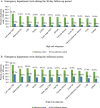Burden of influenza hospitalization among high-risk groups in the United States
- PMID: 36171601
- PMCID: PMC9520810
- DOI: 10.1186/s12913-022-08586-y
Burden of influenza hospitalization among high-risk groups in the United States
Abstract
Background: Seasonal influenza poses a substantial clinical and economic burden in the United States and vulnerable populations, including the elderly and those with comorbidities, are at elevated risk for influenza-related medical complications.
Methods: We conducted a retrospective cohort study using the IQVIA PharMetrics® Plus claims database in two stages. In Stage 1, we identified patients with evidence of medically-attended influenza during influenza seasons from October 1, 2014 to May 31, 2018 (latest available data for Stage 1) and used a multivariable logistic regression model to identify patient characteristics that predicted 30-day influenza-related hospitalization. The findings from Stage 1 informed high-risk subgroups of interest for Stage 2, where we selected cohorts of influenza patients during influenza seasons from October 1, 2014 to March 1, 2019 and used 1:1 propensity score matching to patients without influenza with similar high-risk characteristics to compare influenza-attributable rates of all-cause hospital and emergency department (ED) visits during follow-up (30-day and in the index influenza season).
Results: In Stage 1, more than 1.6 million influenza cases were identified, of which 18,509 (1.2%) had a hospitalization. Elderly age was associated with 9 times the odds of hospitalization (≥65 years vs. 5-17 years; OR = 9.4, 95% CI 8.8-10.1) and select comorbidities were associated with 2-3 times the odds of hospitalization. In Stage 2, elderly influenza patients with comorbidities had 3 to 7 times higher 30-day hospitalization rates compared to matched patients without influenza, including patients with congestive heart failure (41.0% vs.7.9%), chronic obstructive pulmonary disease (34.6% vs. 6.1%), coronary artery disease (22.8% vs. 3.8%), and late-stage chronic kidney disease (44.1% vs. 13.1%; all p < 0.05).
Conclusions: The risk of influenza-related complications is elevated in the elderly, especially those with certain underlying comorbidities, leading to excess healthcare resource utilization. Continued efforts, beyond currently available vaccines, are needed to reduce influenza burden in high-risk populations.
Keywords: Comorbidities; Health resource utilization; Hospitalization; Influenza; Real-world.
© 2022. The Author(s).
Conflict of interest statement
D.H. and C.R. reports financial support from VIR Biotechnology Inc. Y.Y. reports a relationship with VIR Biotechnology Inc. that includes: funding grants. D.H. reports a relationship with Janssen Pharmaceuticals Inc. that includes: employment. D.H. reports a relationship with VIR Biotechnology Inc. that includes: equity or stocks. C.R. reports a relationship with VIR Biotechnology Inc. that includes: employment and equity or stocks. A.N. and J.T. are employees of IQVIA, which received funding from VIR Biotechnology Inc. to conduct this study.
Figures







Similar articles
-
A retrospective cohort study assessing relative effectiveness of adjuvanted versus high-dose trivalent influenza vaccines among older adults in the United States during the 2018-19 influenza season.Vaccine. 2021 Apr 22;39(17):2396-2407. doi: 10.1016/j.vaccine.2021.03.054. Epub 2021 Mar 30. Vaccine. 2021. PMID: 33810903
-
A real-world study evaluating the relative vaccine effectiveness of a cell-based quadrivalent influenza vaccine compared to egg-based quadrivalent influenza vaccine in the US during the 2017-18 influenza season.Vaccine. 2020 Sep 11;38(40):6334-6343. doi: 10.1016/j.vaccine.2020.07.023. Epub 2020 Jul 30. Vaccine. 2020. PMID: 32739119
-
Clinical and economic burden of physician-diagnosed influenza in adults during the 2017/2018 epidemic season in Spain.BMC Public Health. 2022 Dec 17;22(1):2369. doi: 10.1186/s12889-022-14732-2. BMC Public Health. 2022. PMID: 36527015 Free PMC article.
-
Impact of influenza infection on the short- and long-term health of patients with chronic obstructive pulmonary disease.J Med Econ. 2022 Jan-Dec;25(1):930-939. doi: 10.1080/13696998.2022.2098630. J Med Econ. 2022. PMID: 35837794
-
Incidence of Influenza-related Medical Encounters and the Associated Healthcare Resource Use and Complications Across Adult Age Groups in the United States During the 2015-2020 Influenza Seasons.Clin Infect Dis. 2024 Sep 26;79(3):778-786. doi: 10.1093/cid/ciae180. Clin Infect Dis. 2024. PMID: 38567481 Free PMC article.
Cited by
-
The Hospital Burden of Flu in Italy: a retrospective study on administrative data from season 2014-2015 to 2018-2019.BMC Infect Dis. 2024 Jun 8;24(1):572. doi: 10.1186/s12879-024-09446-2. BMC Infect Dis. 2024. PMID: 38851739 Free PMC article.
-
Analysis of Attitudes and Practices towards the Influenza Vaccine in High-Risk Adults in Poland.Vaccines (Basel). 2024 Mar 21;12(3):341. doi: 10.3390/vaccines12030341. Vaccines (Basel). 2024. PMID: 38543975 Free PMC article.
-
Defining the balance between optimal immunity and immunopathology in influenza virus infection.Nat Rev Immunol. 2024 Oct;24(10):720-735. doi: 10.1038/s41577-024-01029-1. Epub 2024 May 2. Nat Rev Immunol. 2024. PMID: 38698083 Review.
-
Safety evaluation of baloxavir marboxil: analysis and discussion utilizing real adverse events from the FAERS database.BMC Pharmacol Toxicol. 2025 May 26;26(1):110. doi: 10.1186/s40360-025-00940-0. BMC Pharmacol Toxicol. 2025. PMID: 40420187 Free PMC article.
-
Immunogenicity and Safety of MF59-Adjuvanted Quadrivalent Influenza Vaccine Compared with a Nonadjuvanted, Quadrivalent Influenza Vaccine in Adults 50-64 Years of Age.Vaccines (Basel). 2023 Sep 26;11(10):1528. doi: 10.3390/vaccines11101528. Vaccines (Basel). 2023. PMID: 37896932 Free PMC article.
References
-
- Centers for Disease Control and Prevention . Disease Burden of Influenza. 2020.
MeSH terms
Substances
LinkOut - more resources
Full Text Sources
Medical

